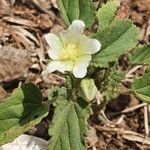Leaf-lamina 2–5 × 0·5–3 cm., usually narrowly ovate but varying from oblong to lanceolate or ovate-lanceolate, apex usually narrowed and subacute but often somewhat rounded, margin sharply and regularly serrate, base usually truncate to rounded sometimes somewhat cordate, upper surface dark green drying brown, thinly and shortly pubescent, glabrescent, lower surface whitish to ash-grey, softly tomentellous; petiole up to c. 3 cm. long, slender, somewhat purplish in older leaves, shortly pubescent, with a callus at the base that is often shortly spinescent; stipules 6–10 mm. long, usually persistent, setaceous.
A small herb or shrub. It grows 30-80 cm high. The leaves have stalks and are arranged in spirals. They are oval but taper towards the tip. There are teeth along the edge. The teeth are small, blunt and of equal size. There is often a small 1 mm long peg below the leaf stalk and a pair of bristle like leaf structures 4-5 mm long on each side. The flowers are small and white or pale yellow. The flower stalk usually has a swelling a little below the flower. The flowers open early in the morning. The fruit are round and in 5 sections.
Annual or perennial woody or suffruticose plant 30–75 cm. tall, often branched from the base, with somewhat virgate erect or occasionally somewhat trailing branches, covered with a dense short stellate pubescence; stems faintly angular to terete, often soon purplish-brown in colour, at length glabrescent.
Annual or weak perennial herb, up to 1 m high. Leaves with blade usually narrowly ovate, 20-50 x 5-30 mm, base truncate to rounded, apex acute or rounded, margins of petiole armed at base with a hooked spur. Flowers: petals 5-6 mm long, pale yellow; Nov.-Mar. Fruit with 5 mericarps, dehiscing at base.
Annual or perennial herb, 0.30-0.75 m high. Petiole with hooked spur at base. Mericarps 5, with 2 awns, disintegrating at base to release seed. Flowers white to yellow.
Flowers white to yellow, solitary or fascicled in the leaf-axils; pedicels rarely more than 15 mm. long, slender to filiform, articulated in the upper 3–5 mm.
Calyx c. 6 mm. long, cupular, 10-ribbed, tomentellous, lobed to about the middle; lobes deltoid, acute, minutely mucronate-apiculate.
Mericarps 5, 4–5 mm. long (including the awns), finely reticulate, with 2 setaceous awns, opening somewhat irregularly at the base.
Seeds c. 1·5 mm. long, dark brown, almost smooth, glabrous.
A woody herb, with branches sometimes lax and trailing
Flowers small, white.
Petals 5–6 mm. long.

